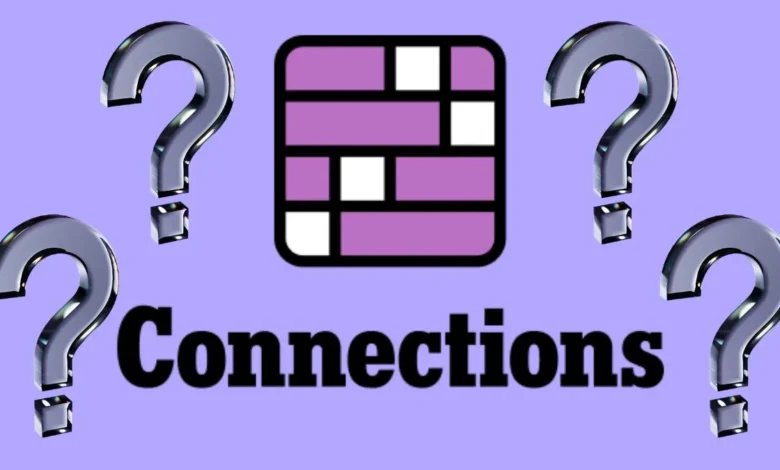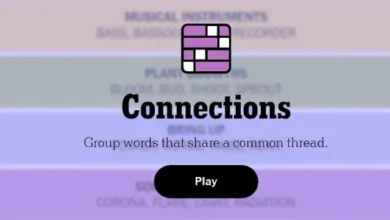The Power of Connections Hint: Unlocking Potential in Your Relationships

Understanding Connections Hint
The term “connections hint” refers to the subtle cues, signals, or indications that individuals use to communicate their feelings, thoughts, or intentions within their interpersonal relationships. These hints may manifest through verbal or non-verbal communication and often serve as the foundation for deeper emotional and intellectual engagement. Recognizing and interpreting these connections hints is crucial because it enables individuals to respond appropriately, thereby fostering stronger, more meaningful relationships.
In both personal and professional contexts, the significance of understanding connections hints cannot be overstated. In personal relationships, these nuances can help partners, family members, and friends navigate emotions and intentions that might otherwise remain unexpressed. For instance, a raised eyebrow or a change in tone might indicate discomfort or enthusiasm, offering an opportunity for a more profound discussion. When individuals are adept at recognizing these signals, they can enhance empathy, reduce misunderstandings, and create an environment that nurtures intimacy.
Similarly, in professional settings, the ability to decipher connections hints is invaluable. Colleagues often rely on implicit cues to gauge reactions during meetings, negotiations, or collaborative tasks. A subtle change in body language or a momentary pause can convey uncertainty, agreement, or disagreement, shaping the dynamics of interactions. By being attuned to these hints, professionals can improve communication and collaboration, ultimately leading to more effective teamwork and productivity.
In conclusion, the understanding of connections hint is essential for cultivating and enhancing relationships. By being aware of and responding to the subtle signals that people send, individuals can develop stronger emotional bonds and facilitate more effective communication in both their personal and professional lives.
The Psychology Behind Connections Hint
Understanding the psychological aspects of connections hint is crucial to grasp how we interact within our social environments. Our brains are wired to interpret a variety of social cues, which are often subtle but profoundly impactful. These cues can range from facial expressions to body language, and they play a significant role in the formation and maintenance of relationships. Emotional awareness, in particular, is vital in navigating these social interactions, as it allows individuals to perceive and comprehend the emotions of others. This heightened sense of awareness fosters empathy, which in turn enhances interpersonal connections.
One key theory in this realm is social intelligence, which refers to the ability to manage and understand social relationships and navigate complex social situations effectively. Individuals with high social intelligence often excel in recognizing connections hint. They can gauge emotions conveyed through nonverbal signals and adjust their responses accordingly. This adaptability is essential in both personal and professional settings, as it enables individuals to form deeper connections, resulting in enriched relationships and improved collaboration.
Moreover, the emotional component of connections hint cannot be discounted. Emotions significantly influence our behaviors and the responses we elicit from others. Positive emotional experiences can strengthen relationships, while negative ones may lead to disconnection. Thus, being emotionally attuned not only aids in recognizing connections hint but also enhances our ability to cultivate supportive and meaningful relationships. By being aware of our own emotions and those of others, we can improve our relational dynamics and foster a more profound understanding of the intricate web of social interactions that govern our lives.
Identifying Connections Hint in Everyday Life
Connections hint can be observed in various situations throughout our daily lives, both in personal interactions and professional environments. Recognizing these signals is paramount for enhancing communication and building strong relationships. For instance, during social gatherings, the body language of individuals can serve as a significant indicator of their openness and interest. Positive signs such as maintaining eye contact, leaning slightly forward, and mirroring another person’s gestures often suggest a willingness to engage and connect. Conversely, closed-off body language, such as crossed arms or a lack of engagement, may indicate discomfort or disinterest.
In workplace settings, identifying connections hint can greatly contribute to a collaborative atmosphere. For example, team members who actively listen, nod in agreement, or provide thoughtful responses during meetings signal their receptiveness to ideas and their desire for connection. Furthermore, observing how colleagues interact during informal conversations—like sharing laughter or offering supportive remarks—can provide insights into the underlying connections present within the team dynamics. These hints can be essential for fostering a culture of collaboration and mutual respect.
Additionally, paying attention to verbal cues can further enrich our understanding of connections. Phrases that express understanding, empathy, or encouragement can indicate a deeper relational connection. For example, someone responding with, “I understand how you feel” or “That makes sense” establishes a sense of validation that strengthens interpersonal ties. Whether engaging in casual chats with friends or navigating complex work projects, being attuned to these connections hint will allow individuals to interpret interactions more effectively.
In conclusion, by consciously observing both verbal and non-verbal signals in everyday interactions, we can enhance our understanding of connections hint. This awareness not only fosters better communication but also leads to stronger, more meaningful relationships in both our personal and professional lives.
The Role of Active Listening in Enhancing Connections
Active listening plays a pivotal role in nurturing and enhancing connections across various relationships. This practice extends beyond merely hearing words; it involves engaging with the speaker, understanding their message, and responding thoughtfully. To truly foster connections, individuals must recognize the nuances and hints within a conversation, which can often hold significant meaning. By employing active listening techniques, one can significantly improve the quality of their interactions and deepen their bonds with others.
One effective technique in active listening is to maintain eye contact and show genuine interest in what the speaker is saying. This non-verbal communication demonstrates attentiveness and encourages the speaker to share more openly. Additionally, summarizing what has been said, or paraphrasing the speaker’s thoughts, can clarify any misunderstandings and confirm that their message has been accurately received. This practice not only validates the speaker’s feelings but also nurtures a shared understanding, paving the way for stronger connections.
Another valuable approach in active listening is asking open-ended questions. These questions can help maintain the dialogue and often prompt the speaker to divulge more personal insights, which are essential in uncovering hints that reflect their emotions and thoughts. Practicing patience is equally crucial; allowing the speaker time to express their feelings without interruption demonstrates respect for their perspective and encourages them to share more freely.
Ultimately, the application of active listening techniques fosters a supportive environment conducive to recognizing connections hint. As individuals become more adept at acknowledging and responding to the hints conveyed by others, they enhance their relationships. This intentional practice not only improves communication but also nurtures mutual understanding, trust, and respect, all of which are fundamental to building lasting connections.
Building Stronger Relationships Through Connections
Establishing strong relationships is essential for both personal and professional success. The concept of connections hint can serve as a valuable tool in enhancing these relationships. It involves recognizing the underlying links and shared experiences that bond individuals, thereby facilitating deeper interactions and understanding. By harnessing this concept, individuals can create more meaningful connections and improve the quality of their relationships.
One effective strategy for utilizing connections hint is to practice active listening. Engaging fully in conversations and demonstrating genuine interest not only shows respect but also helps in identifying common interests and experiences. This approach fosters a sense of empathy and encourages open dialogue. When both parties feel heard, the likelihood of establishing a strong connection increases significantly.
Another approach is to prioritize quality time spent together. This can involve scheduling regular catch-ups or joining activities that resonate with both individuals’ interests. Whether it is through shared hobbies, professional events, or casual meet-ups, consistent interaction strengthens bonds. The intentionality behind these encounters reinforces the significance of the connections hint, creating an environment where relationships can flourish.
Setting goals within relationships can also be beneficial. Discussing aspirations and collaborative projects can build a sense of teamwork and shared vision, which naturally enhances connections. By working towards common objectives, individuals can deepen their understanding of each other, thereby harnessing the power of connections hint more effectively.
In addition, being aware of and expressing appreciation for one another’s strengths can solidify connections. Acknowledging the unique qualities and contributions of others cultivates a positive atmosphere, encouraging deeper emotional ties. By infusing this appreciation into daily interactions, reliance on connections hint is augmented, leading to healthier, more fulfilling relationships.
Connections Hint in the Workplace
In today’s fast-paced professional environment, understanding and recognizing connections hint can significantly impact workplace dynamics. Interpersonal relationships serve as the backbone of effective teamwork, and by acknowledging the nuances of these connections, organizations can foster a collaborative culture that drives success. By identifying hints or cues in social interactions, employees can better interpret their colleagues’ emotions, motivations, and needs, which ultimately leads to a more harmonious workplace.
When employees actively listen and engage with one another, they begin to build trust and rapport. This relationship-building process not only enhances communication but also encourages a sense of belonging among team members. A supportive workplace culture that values connections hint can lead to increased morale, job satisfaction, and overall employee well-being. Moreover, by integrating these relational aspects into everyday work life, teams can create an environment where every member feels valued and empowered to contribute their best work.
The impact of strong interpersonal connections extends beyond morale; it translates directly into productivity. Teams that understand and leverage the hidden hints within their relationships can streamline collaboration. This can result in reduced misunderstandings and conflicts, allowing employees to focus on their tasks rather than navigating interpersonal challenges. Furthermore, fostering an environment that encourages open dialogue and feedback is crucial. When employees feel comfortable sharing their thoughts and concerns, it nurtures innovation and creativity, as individuals are more likely to share ideas and solutions.
Ultimately, the ability to recognize and cultivate connections hint in the workplace is paramount. Organizations that prioritize these relationships not only see improved teamwork and productivity but also foster an inclusive environment where all employees can thrive. Embracing the power of interpersonal connections is essential for achieving long-term career success and organizational goals.
Overcoming Challenges in Recognizing Connections
Recognizing the subtle nuances of connections hint can often be impeded by a variety of challenges. Individuals frequently encounter miscommunications that distort their understanding of interpersonal relationships. One common issue is the discrepancy between verbal and non-verbal cues. Often, a person’s words do not align with their body language, leading to confusion and misunderstandings. To combat this, it is essential to become attuned to non-verbal signals, such as facial expressions and body posture, which can provide deeper insight into the true meanings behind words.
Biases also pose significant obstacles in interpreting connections hint. Preconceived notions about individuals based on their background, appearance, or past interactions can cloud judgment and lead to misinterpretations. To overcome these biases, one must consciously reflect on personal beliefs and challenge stereotypical thinking. Engaging in practices such as perspective-taking—actively considering situations from another person’s standpoint—can foster better communication and understanding, ultimately helping to clarify intentions and feelings.
Another fundamental element in recognizing connections hint lies in developing sensitivity toward others’ feelings. This practice involves actively observing and acknowledging emotional cues, such as tone of voice and silence, which can indicate discomfort or enthusiasm. Strengthening emotional intelligence can enable individuals to respond more thoughtfully, creating a space for open dialogue. Attending workshops or engaging in self-study focused on effective communication strategies can aid in honing these skills.
By addressing miscommunications, challenging biases, and fostering emotional awareness, individuals will find themselves better positioned to interpret the connections hint present in their relationships. These improvements not only enhance personal connections but also contribute to building a more empathetic and understanding community.
The Impact of Cultural Differences on Connections
Cultural differences play a significant role in shaping our understanding and interpretation of connections. Each culture carries its own set of values, practices, and social norms, which inherently influence how relationships are initiated, maintained, and perceived. For instance, in some cultures, establishing connections may prioritize collective well-being and community, while in others, individualism may drive interpersonal interactions. This diversity in relationship dynamics highlights the necessity for cultural sensitivity when engaging with individuals from different backgrounds.
Understanding the cultural context is vital in facilitating meaningful connections. For example, certain cultures may value direct communication and assertiveness, leading to an expectation of clarity and frankness in discussions. Contrarily, other cultures might emphasize indirect communication, where subtlety and nuance are preferred. Navigating these differences can lead to misunderstandings or discomfort without proper awareness and adaptation. This can have profound implications in personal relationships and professional interactions, where effective communication is key to nurturing connections.
Moreover, cultural rituals, traditions, and practices can also influence how connections are expressed and maintained. In some societies, relationship-building may involve formal ceremonies or communal activities that reinforce ties, while in others, casual gatherings may suffice. It is essential to appreciate and respect these variations, as failing to do so can alienate individuals and hinder the formation of strong bonds.
Ultimately, the ability to recognize and adapt to cultural differences enhances our relational capabilities. By fostering an environment of openness and curiosity, we can learn to appreciate the unique perspectives that different cultures bring to the table. Engaging with these distinctions not only enriches our social interactions but also strengthens our collective ability to form meaningful connections that transcend cultural barriers.
Conclusion: The Long-term Benefits of Mastering Connections Hint
In the exploration of connections hint, it is crucial to recognize their profound impact on our personal and professional lives. Understanding the dynamics of relationships through effective communication and emotional intelligence is more than a mere skill; it is a transformative process that can foster deeper connections. Individuals who actively engage in building and nurturing these connections often witness a remarkable enhancement in their relationships, leading to a robust support system that is invaluable in various aspects of life.
Moreover, the practical application of connections hint can significantly improve interaction quality within professional environments. By cultivating these relationships, individuals open doors to collaboration, mentorship, and networking opportunities that can facilitate career growth. The ability to connect with colleagues, clients, and business partners on a more profound level not only enhances job satisfaction but also drives innovation and productivity within teams.
The longevity of connections hint further emphasizes the importance of nurturing these relationships over time. As trust builds and understanding deepens, individuals can confront challenges more effectively and celebrate successes together. These relationships often yield mutual benefits, contributing to personal satisfaction and a sense of belonging, which are essential for overall well-being.
As we conclude, it is evident that mastering the principles of connections hint is an investment in oneself and one’s future. Readers are encouraged to embrace the strategies discussed throughout this blog and apply them in their daily interactions. The long-term benefits of harnessing the potential of connections are immense, paving the way for richer, more rewarding relationships that can greatly enhance both personal and professional spheres.
You May Also Read This Dailytimenews.




